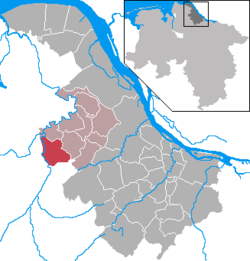
The Prince-Archbishopric of Bremen, also Archbishopric of Bremen, — not to be confused with the former Archdiocese of Bremen, and the modern Archdiocese of Hamburg, founded in 1994 — was an ecclesiastical principality (787–1566/1648) of the Holy Roman Empire, which after its definitive secularization in 1648, became the hereditary Duchy of Bremen. The prince-archbishopric, which was under the secular rule of the archbishop, consisted of about a third of the diocesan territory. The city of Bremen was de facto and de jure not part of the prince-archbishopric. Most of the prince-archbishopric lay rather in the area to the north of the city of Bremen, between the Weser and Elbe rivers. Even more confusingly, parts of the prince-archbishopric belonged in religious respect to the neighbouring diocese of Verden, making up 10% of its diocesan territory.

Bremen-Verden, formally the Duchies of Bremen and Verden, were two territories and immediate fiefs of the Holy Roman Empire, which emerged and gained imperial immediacy in 1180. By their original constitution they were prince-bishoprics of the Archdiocese of Bremen and Bishopric of Verden.

Kranenburg is a municipality in the district Stade, Lower Saxony, Germany, lying on the river Oste. It consists of the villages Kranenburg and Brobergen and is part of the Samtgemeinde Oldendorf-Himmelpforten. It has a population of 772 as at December 31, 2003, of which 546 in Kranenburg and 226 in Brobergen.
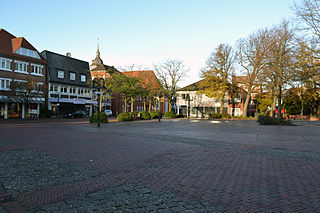
Bremervörde is a town in the north of the district (Landkreis) of Rotenburg, in Lower Saxony, Germany. It is situated on the Oste river near the centre of the "triangle" formed by the rivers Weser and Elbe, roughly equidistant from the cities of Hamburg, Bremen and Cuxhaven.

Fredenbeck is a municipality northwest of Hamburg (Germany) in the district of Stade in Lower Saxony.

Zeven [] is a town in the district of Rotenburg, in Lower Saxony, Germany. It has a population of around 14,000. The nearest large towns are Bremerhaven, Bremen and Hamburg. It is situated approximately 22 km northwest of Rotenburg, and 40 km northeast of Bremen. Zeven is also the seat of the Samtgemeinde Zeven.
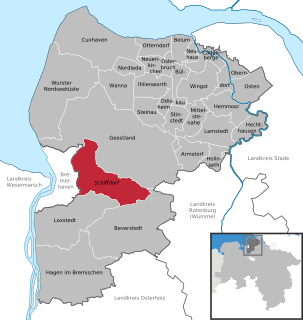
Schiffdorf is a municipality in the district of Cuxhaven, in Lower Saxony, Germany. It is situated at the eastern boundary of the Bremian city of Bremerhaven, and 35 kilometers south of Cuxhaven.
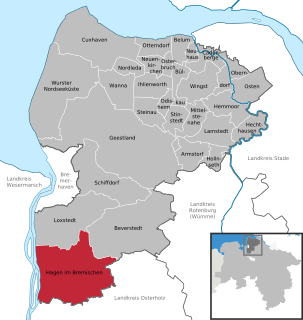
Hagen im Bremischen is a municipality in the district of Cuxhaven, in Lower Saxony, Germany. It is situated approximately 20 km south of Bremerhaven, and 35 km northwest of Bremen. Hagen was the seat of the former Samtgemeinde Hagen.

Gnarrenburg is a municipality in the district of Rotenburg, in Lower Saxony, Germany. It is situated approximately 15 km southwest of Bremervörde, and 40 km northeast of Bremen.

Balje is a municipality in the district of Stade, in Lower Saxony, Germany.
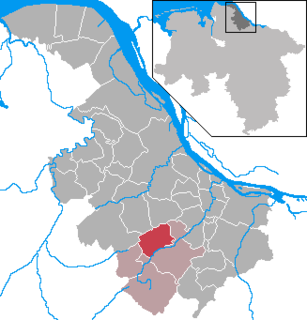
Bargstedt is a municipality in the district of Stade, Lower Saxony, Germany.

Beckdorf is a municipality in the district of Stade, Lower Saxony, Germany.

Brest is a municipality in the district of Stade, Lower Saxony, northern Germany.

Deinste is a municipality in the district of Stade, Lower Saxony, Germany.

Freiburg (in High German, officially Freiburg an der Elbe; short: Freiburg/Elbe, Freiborg/Elv, or Freiborg is a municipality in the district of Stade, Lower Saxony, Germany.
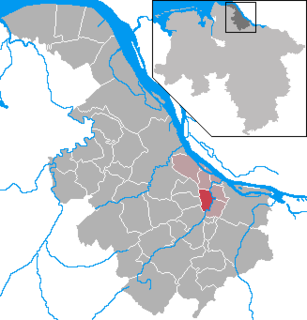
Guderhandviertel is a municipality in the district of Stade, Lower Saxony, Germany.
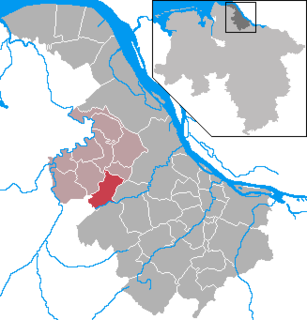
Heinbockel is a municipality in the district of Stade, Lower Saxony, Germany.

Kutenholz is a municipality in the district of Stade, Lower Saxony, Germany.

Oederquart is a municipality in the district of Stade, Lower Saxony, Germany.

The historic territory of Verden emerged from the Monarchs of the Frankish Diocese of Verden in the area of present-day central and northeastern Lower Saxony and existed as such until 1648. The territory managed by secular lords for the bishops was not identical with that of the bishopric, but was located within its boundaries and made up about a quarter of the diocesan area. The territory was referred to at the time as Stift Verden or Hochstift Verden, roughly equating to Prince-Bishopric of Verden. This territory described in local sources today incorrectly as Bistum Verden and, in 1648, was given the title Principality of Verden, sometimes referred to as the Duchy of Verden.

